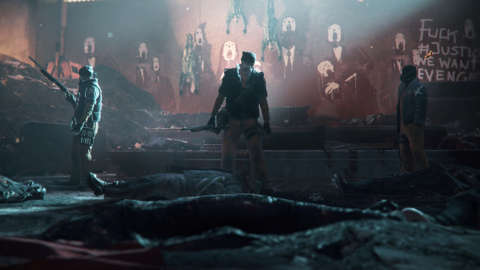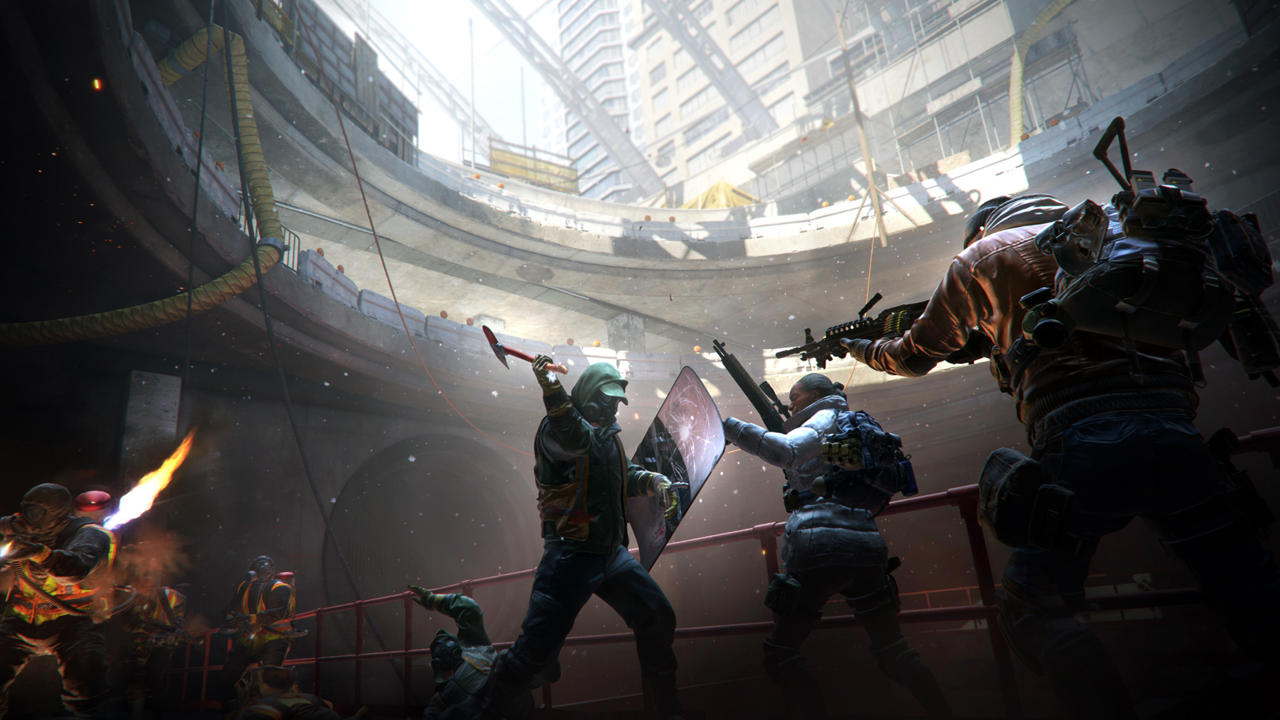After a full two-year delay, some part of me wasn't sure Ubisoft's open world, third-person shooter The Division would ever come out. Even when we were allowed a brief taste of the game's nebulous Dark Zone multiplayer hubs at E3 2015, we only saw a tiny, tightly controlled fraction of the overall experience. At a recent press event, however, I finally sat down with a nearly finished build of the game and played through the first few hours of The Division's cooperative campaign.
Despite the massively multiplayer ambitions hinted at in the game's earliest trailers, The Division is not an MMO. Its realistic recreation of midtown Manhattan will not be populated by human players throughout like, say, DayZ; rather, you'll only find large groups of random players in Destiny-style social hub areas that occupy small, specific pockets of the world map. For the majority of the game, you'll simply partner with up to three co-op buddies and battle AI enemies across a series of discrete, story-driven missions.
Paper Mario: The Thousand-Year Door – Official Switch Overview Trailer Sand Land Review Stellar Blade - Official Launch Trailer | PS5 Games SaGa Emerald Beyond – Official Launch Trailer Another Crab's Treasure Is A Soulslike 3D Platformer | GameSpot Review Stellar Blade Review That Time I Got Reincarnated as a Slime ISEKAI Chronicles – Official Announcement Trailer MEGATON MUSASHI W: WIRED – Official OP “MUSASHI English Ver.” Trailer Gothic 1 Remake | Official Collector's Edition Trailer Super Monkey Ball Banana Rumble - Official Multiplayer Features Trailer PUBG | Erangel Classic Returns Genshin Impact - "Arlecchino: Afterglow of Calamity" | Collected Miscellany
Please enter your date of birth to view this video
By clicking 'enter', you agree to GameSpot's
Terms of Use and Privacy Policy
This is where my hands-on experience kicked off, with New York City rapidly descending into chaos following a biological attack that saw smallpox-infected currency deliberately introduced into circulation on Black Friday, both ensuring an outbreak and sending a sadistic message about American consumerism. As quarantine turned to panic and major public institutions began to fail, three factions emerged: random, opportunistic looters; a band of escaped convicts called the Rikers; and the Cleaners, a paranoid militia determined to end the pandemic by simply burning everyone alive. Members of the eponymous Division have been sent by the government to combat these threats and restore order to an ailing city.
After quickly customizing a character--selecting from a relatively modest collection of premade faces and hairstyles--a chopper dropped me near the Hudson Piers en route to the game's first mission: establish a command center at the historic post office across from Madison Square Garden. Once activated, this expansive, regal building becomes your home base for the rest of the game, providing a place to receive missions, purchase gear, craft items, and interact with the game's characters.

It also serves as the driving force behind the game's narrative. The base consists of three wings--medical, tech, and, security--and each branch contains its own storyline, with dedicated missions that eventually result in related unlocks and upgrades. As you rebuild each area, you'll need to work with three distinct mission-givers: a respected virologist who's key to containing the pandemic; an ex-military engineer capable of restoring the city's vital infrastructure; and the head of the game's only friendly faction, the Joint Task Force.
After walking through the front door and claiming the post office in the name of truth and justice, my first real taste of The Division's combat came as my squad and I set out to rescue the doctor who eventually supplies the medic missions. Interestingly, the moment-to-moment combat feels more like an RPG imbued with shooter mechanics than a shooter layered with RPG trappings. Enemies, for example, absorb an absurd amount of damage, far more than you'd expect based on the game's grounded universe. Though big, bold damage indicators explode off your targets with each shot, average bad guys can still withstand four or five headshots before crumpling to the ground. More than once, I emptied an entire clip into an enemy but still had to reload to finish him off.
More than once, I emptied an entire clip into an enemy but still had to reload to finish him off.
The controls feel oddly un-shooter-like as well, at least by modern standards. In order to throw a grenade, you must hold left on the d-pad, select a grenade type, bring up a throwing arc with the left trigger, and finally throw your explosive with the right trigger. Similarly, aiming down the sights with a scoped weapon doesn't automatically bring up the scope; to do that, you must also click in the right joystick. I could go on, but to be clear, everything still functioned fine in my experience; it just didn't always match my expectations for a modern shooter.
Plus, once I grew accustomed to these gameplay idiosyncrasies, I did find plenty to love about The Division's action. The sticky cover system allows you to seamlessly move between objects in the environment. The health bar is divided into three segments, and as long as a segment isn't completely depleted, it will regenerate. Characters can swap between two fully upgraded primary weapons--in addition to a standard sidearm and other weaponry--rather than just one. All of these design decisions allow action to maintain its momentum and become that much more gratifying.

Most importantly, though, enemy AI proved savvy enough to demand strong squad tactics from me and my teammates. If we didn't hold the line, we would get flanked and murdered, but if we successfully laid down suppressive fire and forced the opposition into a corner, we could flank them and save ourselves a bloody firefight. And when strategy didn't quite pan out, I was generally able to rely on my character's special abilities to turn the tables. The Division's upgrade and progression systems are extensive, offering three separate categories of both passive and active abilities: skills, talents, and perks.
Skills are most definitely active, allowing you to, say, unleash an enemy-seeking mine or break out a riot shield and march into the crossfire unscathed. There are 12 skills total--four in each of the three base branches--and can be unlocked in any order using skill points you receive as you level up. You can map any two unlocked skills to the bumpers, and eventually even equip a "special" skill triggered by pressing both bumpers simultaneously. To add even more depth, every skill can be augmented and improved over time: your deployable turret can become a fire turret, the healing circle cast by your medic skill can grow wider, and so on. Talents and perks, on the other hand, are both passive and unlock as you complete missions and upgrade your base. Perks like quicker reloads and more grenade slots are permanent, but you can only equip four talents at a time.
The loot system is equally robust, with nearly a dozen individually upgradable pieces of gear like backpacks and body armor, plus a huge selection of weapon mods so you can turn any firearm into your own custom killing machine. You can break down gear into base components in order to craft new items, purchase uncommon gear from vendors, and, of course, collect loot off fallen enemies out in the world. Thankfully, all players get unique random loot drops that only appears in their own game, meaning you never have to worry about your friend grabbing all the best stuff.

As you might imagine, inventory management falls somewhere between involving and overwhelming, but it didn't take long for that classic gamer gear lust to grip me. Although I didn't find any paritcularly rare or exoctic weapons, I was always excited to find a new rifle that bumped up my max damage numbers up ever so slightly. I was also extremely grateful that I was able to adjust everything about my character on the fly, including skills, talents, weapons, weapon mods, apparel, and more. There are no hard classes in The Division, only ability combinations and weapon loadouts.
The one major question that remained after my hands-on time: What will we find as we explore the streets of New York City? I was able to engage in a few simple side quests, but I didn't have much time to really explore. Will we find encampments of survivors? A diverse collection of environments? Special loot that rewards collectors? Regardless, it's exciting to know the entire map is open from the moment you establish your headquarters. You might find enemies who drastically outrank you, but assuming you aren't slaughtered on sight, you'll never run into any invisible walls. The only exception to this rule: heavily infected areas that may require a better gas mask than whatever you have equipped.
Fortunately, whatever mysteries remain won't stay secret for long. The Division's long-awaited beta begins later this month.

